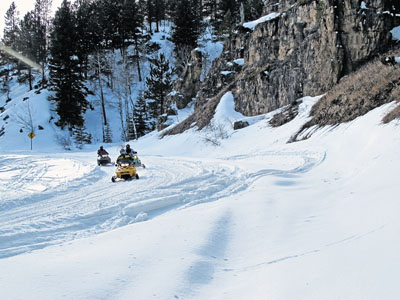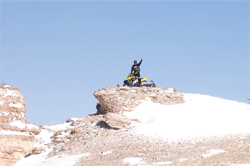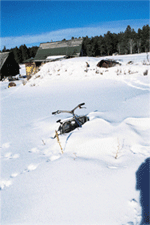 The area had seen uncharacteristically warm weather for a few weeks prior to our April visit, but when an area averages 30 to nearly 42 feet of snow per year, it’s pretty much guaranteed that snowmobiling in Lake Tahoe can continue late into the spring.
The area had seen uncharacteristically warm weather for a few weeks prior to our April visit, but when an area averages 30 to nearly 42 feet of snow per year, it’s pretty much guaranteed that snowmobiling in Lake Tahoe can continue late into the spring.
After taking in the sights and stuffing our excess gear into all possible compartments, we saddled up on our Arctic Cat T660 rentals and did some more cruising. We began the first of a two-day ride near Meyers, California, and toured the southern Lake Tahoe region on our snowmobiles.
The Lake Tahoe area is best known, perhaps, for its downhill skiing. But it is also home to some of the finest snowmobiling possible. While thousands converge on the downhill ski slopes, there are thousands of others who fire up their sleds and head into the backcountry. It’s hardly a secret getaway — the area has hosted several hillclimb races over the years, and has hosted other snowmobile-related events.
Lake Tahoe is located a mere 38 miles from downtown Reno, Nevada. The lake offers 72 miles of scenic shoreline and is 6,200 feet above sea level. It has been claimed that the water is so pure that a white dinner plate is visible 78 feet below the surface. While the lake offers its splendor and sights, there are several trailheads and plenty of trails and off-trail riding around the lake.
The area boasts an average of 274 sun-filled days per year. In January the average high temperature is 36 degrees, making it comfortable for riding. Areas abound on the California and Nevada side of Lake Tahoe for riding, and because of its heavy tourism there are plenty of places to stay. And if you’re the gambling type, finding a casino or gambling establishment is easy on the Nevada side — especially in Reno. It is home to 186,000 residents, roughly five million visitors each year, a plethora of large and small casino hotels and nearly 30,000 slot machines.
Prior to starting our ride on the first day, we checked in at the Lake Tahoe Adventures office, signed the appropriate paperwork and then drove south. Near Carson Pass and the Kirkwood Mountain Ski Resort, we met up with our guide, Paul.
It felt like a warm June day. After meeting Paul, he led us to our steeds for the day – an Arctic Cat T660 and T660 Turbo. Soon we were cruising down the trail following Paul’s lead.
He turned off the trail and we picked our way through the trees. The snow, compact and wet, was almost like cement as we wove in and out of the trees. Paul surveyed the snow around him like he was looking for something. Perhaps he lost a personal item? Quite the contrary. We soon stopped in an opening. “Sometimes you can see bear,” Paul said. “They just came out of hibernation.”
Gulp. “Do you mean grizzlies?” we asked nervously. “Nah, black bears,” he replied.
We looked around for a few more minutes and, thankfully, saw no bears. Paul pointed to an unnamed peak in the distance and said we were on our way there. The peak we were headed to had never been named, so Paul took it upon himself to name it: appropriately “Paul’s Peak.” It’s not official, and you probably won’t find the name on a map, but it sounded good to us. Having been a guide and rescue worker in the area for several years, he has probably earned it.
Paul led us out of the trees and into a wide-open area. We cruised over small hills and then started our ascent toward the top of a peak. Rocks poked out through the snow, and the normally aspirated T660 worked overtime to make the climb.
When we neared the top of the peak we stopped for the 360-degree view of the surrounding Sierra Nevada mountains. We were above the tree line and below us was Hope Valley. It was like we were pioneers from the 19th century seeing the landscape and beauty for the first time. The quiet and solitude of the mountains engulfed us.
We mounted up and made our descent. We took a slightly different route, and got surrounded by rock outcroppings. We doubled back, and Paul led us down a different area. Eventually we ended up at the edge of a wilderness area, which is off limits to motorized vehicles and other recreational activities. In the snow, stakes that are no more than 4-inches wide mark the wilderness area. We steered clear of it and continued our decent.
Upon nearing Hope Valley, we again picked our way through the trees. With the warmth, we had to watch for creeks and running water under the snow. Some areas that had opened up were 5 feet deep, and falling into a gulch would be bad news. As we got to the valley floor, we followed a fast-running creek to the trail and headed back to the trailhead and then parked our sleds for the night.
North Tahoe
After touring the southern part of Lake Tahoe country, we decided that a ride near the northern edge of the lake was in order. So we hooked up with an “attendant” (the company doesn’t have a guide permit) from The Ski Barn, located in King’s Beach, California. Since we didn’t have our own sleds with us, our attendant, Heath, towed the rentals to our starting point.
We started at a trailhead off of U.S. Highway 89 near Truckee, California. We planned to ride on the Little Truckee Summit trail system in the Tahoe National Forest. About a half-dozen other trucks and trailers were parked alongside the trailhead. With the warm weather and few other trucks and trailers, we knew we’d have most of the trails and backcountry to ourselves. Heath unloaded the Polaris RMKs and we suited up to ride. The air was warmer than the day before, and we picked our way across the asphalt and onto the trail. With the warm temperatures, the snow was sticky again. We blazed down the trail, kicking up ice chunks and snowballs behind us. It was a perfect day for spring riding.
After a few miles we came upon an open field. Sweating and breathing hard from the race-like romp, we had to rest and ditch some riding gear. After the much-needed break, we continued trailblazing toward Webber Lake. Webber Lake, which was once known as Truckee Lake, is home to the Webber Lake Hotel. David Gould Webber, who owned much of the land surrounding the lake, built the hotel in 1860. It is still in use today and trail maps are available there.
We continued on past the hotel and the lake. A few minutes later, we stopped along the tree-lined trail at the bottom of a ridge. Heath said there was a play area he wanted to take us to, but we would need to find a clear passage over the ridge. He fired up his RMK and went to find a safe path. We stayed behind, kicked back and let the sun warm our faces. Within minutes, Heath was back and said he found a trail leading to the top of the ridge. It was thick with trees, he said, and we would need to go slow.
We followed him up the trail making slow, calculated turns around large and small pine trees. Sometimes the skis on our sleds barely made it between some of the trees. When we neared the top, the hill got steeper and the trees parted. We gunned it to the top of the ridge, and to the view that awaited us.
Upon reaching the ridge top, we saw a wide-open valley — a big play area — below us. Mountains surrounded us. We took in the sights for a few minutes and then followed the narrow ridgeline to a rocky outcropping before turning off and plunging to the valley below.
Once we got to the valley, it was time to play. We blasted across the snow with the throttle pinned to the bars. We climbed the hills around us. We marked up as much of the valley as we possibly could. One mountain peak looked tempting to climb, but there was evidence of two recent avalanches so we kept our distance. Heath, however, rounded us up and led us to the safe side of that mountain. We then drove up the side to its peak. The view was nothing short of spectacular.
About a half-hour later, we remounted our sleds, descended the mountaintop and left the play area. We retraced our tracks back to the trail. Heath led the way and took us on some different trails as we headed back to the trailhead. With the afternoon sun and warm weather, the trails were starting to get slushy, but the riding was still good.
Soon, we were shooting down the trailhead road, dodging dirt, rocks and other bare spots. In minutes, we were back at the trailhead, our ride for the day was complete and our season was capped off with stress-free riding and a nice tan.
Lake Tahoe Adventures
From snowmobiles to ATVs to Hummers to Jeeps, Lake Tahoe Adventures offers a tour for anyone. The outfit rents four-stroke powered snowmobiles – mostly Arctic Cat T660s. They offer several guided tours including scenic trail, ultimate off-trail and specialty rides. Reservations are required so be sure to call ahead.
800/865-4679 or 530/577-2940
www.laketahoeadventures.com
The Ski Barn
The Ski Barn, with Full Throttle snowmobile rentals, is one of the only outfits that rents two-stroke-powered snowmobiles in the area. There are no official guided tours available, only rentals. Located on the north side of the lake in King’s Beach, The Ski Barn has several rental options available. Snowmobile rentals include a 600 or 700 RMK, trailer, helmet and first tank of gas. Renters can choose to tow the sleds or have The Ski Barn tow them to a rendezvous area.
530/546-8774; www.thebeachbarn.com
Planning Your Trip
There are several Web sites available to assist in planning a trip to Lake Tahoe. The Lake Tahoe Visitors Authority site offers several features that can help you plan an itinerary. Visit www.bluelaketahoe.com for more information.
Lake Tahoe Facts
•Lake Tahoe is 22 miles long and 12 miles wide.
•The average depth is 989 feet.
The deepest point is 1,685 feet, making it the third deepest lake in the United States.
•The water in the lake is 99.7 percent pure, which is about the same as distilled water.
•It is 6,229 feet above sea level.




